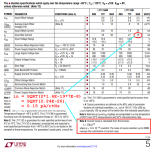Four times higher is not ultra-high in my book but of course it is a factor to consider.That depends on the application, the OPA1602 and OPA1612 are ultrahigh noise current op-amps compared to the NE5534A.
It makes a big difference in applications that are sensitive to current noise, such as MC phono inputs. Run a sim. Remember to include the inductance of the cartridge. The numbers don't like.Four times higher is not ultra-high in my book but of course it is a factor to consider.
Tom
Ah. DUH. Yes. MM. The impedance of the inductance of the cartridge really wrecks the noise performance once you take the current noise into account. I ran an analysis recently and to my surprise the NE5534 was still one of the top performers. My personal favourite, the LM4562, was considerably noisier in that application. But some of the modern opamps such as the OPA1642 performed well.MM you mean?
Tom
Regarding the current noise of OPA1602 and 1612,
In the case of BJT input, there is generally a trade-off between voltage noise and current noise, but I found it strange that the OPA1602 has a slightly larger current noise than the OPA1612 according to the data sheet specifications, so when I actually measured that, I found that the current noise of the OPA1612 is close twice that of the OPA1602.
The value I measured.
OPA1602: 1.82pA/√Hz (Substantial current noise), 1.06pA/√Hz (common mode canceled current noise)
OPA1612: 3.34pA/√Hz (Substantial current noise), 1.54pA/√Hz (common mode canceled current noise)
OPA1602 may list actual noise, and OPA1612 may list noise that cancels common mode.
NE5534, NJM5534, NE5532, and NJM5532 all have a range of 3.4 to 5.5pA/√Hz, and the values after canceling the common mode are also almost the same.
If with bias cancellation, you won't know until you actually measure it.
In the case of BJT input, there is generally a trade-off between voltage noise and current noise, but I found it strange that the OPA1602 has a slightly larger current noise than the OPA1612 according to the data sheet specifications, so when I actually measured that, I found that the current noise of the OPA1612 is close twice that of the OPA1602.
The value I measured.
OPA1602: 1.82pA/√Hz (Substantial current noise), 1.06pA/√Hz (common mode canceled current noise)
OPA1612: 3.34pA/√Hz (Substantial current noise), 1.54pA/√Hz (common mode canceled current noise)
OPA1602 may list actual noise, and OPA1612 may list noise that cancels common mode.
NE5534, NJM5534, NE5532, and NJM5532 all have a range of 3.4 to 5.5pA/√Hz, and the values after canceling the common mode are also almost the same.
If with bias cancellation, you won't know until you actually measure it.
Ah. DUH. Yes. MM. The impedance of the inductance of the cartridge really wrecks the noise performance once you take the current noise into account. I ran an analysis recently and to my surprise the NE5534 was still one of the top performers. My personal favourite, the LM4562, was considerably noisier in that application. But some of the modern opamps such as the OPA1642 performed well.
Tom
I usually calculate the cartridge impedance at 3850 Hz for RIAA- and A-weighting or at 5179 Hz for RIAA- and ITU-R 468 weighting, multiply the noise current with the impedance, add the square to the square of the noise voltage and take the square root. The noise current of the 47 kohm termination resistor already has about as much impact as 7 nV/√Hz when the cartridge inductance is 500 mH.
Oops, excuse me.
The range of 0.34 to 0.55pA/√Hz is correct.
I got one digit wrong.NE5534, NJM5534, NE5532, and NJM5532 all have a range of 3.4 to 5.5pA/√Hz, and the values after canceling the common mode are also almost the same.
The range of 0.34 to 0.55pA/√Hz is correct.
Is it still odd?That's odd, as it should be far less than that for an NE5534, at least at 1 kHz and higher.
Sure. It's also $10/each.It appears to me that the LT1113 has far less current noise (datasheet MAX) than the NE5534 (datasheet TYPICAL)
I seem to recall that the OPA627 (~$30/ea) is better than the NE5534 as well.
But not everybody finds it reasonable to blow $10-30 on an opamp.
I just tried the different opamps in a simulation of a well thought out RIAA stage (from Doug Self's Small Signal Audio Design book) and looked at the total integrated noise at the output.I usually calculate the cartridge impedance at 3850 Hz for RIAA- and A-weighting or at 5179 Hz for RIAA- and ITU-R 468 weighting, multiply the noise current with the impedance, add the square to the square of the noise voltage and take the square root.
Tom
I've just been through some of my stash of random interesting opamps, and noticed the ADA4625 as a plausible replacement for the NE5534/32 that ticks all the performance boxes.
It's JFET input (low current noise), 3.3nV/√Hz voltage noise, rail-to-rail, +/-2.25V to +/-18V, 0.0003% THD (2k load), unity gain stable, and comes in both single and dual forms, SOIC8. Bit pricey though (its got an outrageously low offset voltage)
Here's the distortion v. freq plots for 2k load at various levels (inverting gain = -1)

It's JFET input (low current noise), 3.3nV/√Hz voltage noise, rail-to-rail, +/-2.25V to +/-18V, 0.0003% THD (2k load), unity gain stable, and comes in both single and dual forms, SOIC8. Bit pricey though (its got an outrageously low offset voltage)
Here's the distortion v. freq plots for 2k load at various levels (inverting gain = -1)
- Home
- Source & Line
- Analog Line Level
- NE5534A end of life announced

